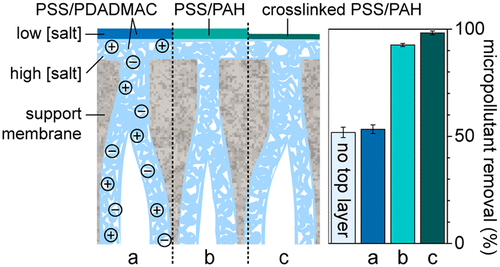当前位置:
X-MOL 学术
›
ACS Appl. Polym. Mater.
›
论文详情
Our official English website, www.x-mol.net, welcomes your feedback! (Note: you will need to create a separate account there.)
Multiple Approaches to the Buildup of Asymmetric Polyelectrolyte Multilayer Membranes for Efficient Water Purification
ACS Applied Polymer Materials ( IF 5 ) Pub Date : 2020-01-27 , DOI: 10.1021/acsapm.9b01038 Esra te Brinke 1 , Iske Achterhuis 1 , Dennis M. Reurink 1 , Joris de Grooth 1 , Wiebe M. de Vos 1
ACS Applied Polymer Materials ( IF 5 ) Pub Date : 2020-01-27 , DOI: 10.1021/acsapm.9b01038 Esra te Brinke 1 , Iske Achterhuis 1 , Dennis M. Reurink 1 , Joris de Grooth 1 , Wiebe M. de Vos 1
Affiliation

|
The versatility of polyelectrolyte multilayer (PEM) coatings is very promising for their use as separation layers in nanofiltration applications. These membranes can for example be suited for the removal of micropollutants, such as medicines and pesticides, from water. The selectivity of PEM coatings can be further improved by so-called asymmetric coating. In this approach, the pores of the support membrane are filled with an open PEM layer to maintain a good water permeability, and subsequently a thin, dense layer is coated on top to determine the separation properties. Coating a dense top layer can be achieved in different ways. In this work, we systematically investigate the effectiveness of these different types of top layers. We show that coating a top layer at lower ionic strength than the bottom layer leads to a higher permeability and MgSO4 retention, compared with the reference, bottom-type layer coated with the same total number of layers. Also, other salt retentions can be improved with this approach. However, micropollutant retentions are hardly affected. Coating a top layer with a polyelectrolyte pair that forms denser layers at equal ionic strength, in contrast, leads to a significant change in separation properties with much higher MgSO4 and micropollutant retentions and improved water permeability compared with the reference layer. The concept of membrane optimization via asymmetric coating is thus most effective when using different polyelectrolyte pairs on top of each other. Moreover, we show that this approach allows us to selectively cross-link the top layer for further enhancement of the micropollutant retention, while water permeability is not much reduced. Asymmetric PEM coatings are therefore a promising method to optimize PEM membranes for micropollutant removal and other separation processes.
中文翻译:

建立不对称聚电解质多层膜的多种方法以实现高效水净化
聚电解质多层(PEM)涂层的多功能性非常适合用作纳滤应用中的分离层。这些膜可以例如适合于从水中去除微量污染物,例如药物和农药。PEM涂层的选择性可以通过所谓的不对称涂层进一步提高。在这种方法中,支撑膜的孔被开放的PEM层填充,以保持良好的水渗透性,随后在其顶部涂覆了一层致密的薄层,以确定分离性能。可以以不同的方式涂覆致密的顶层。在这项工作中,我们系统地研究了这些不同类型的顶层的有效性。我们表明,以比底层更低的离子强度涂覆顶层会导致更高的渗透性和MgSO4.保留率,与参照物相比,底涂型层的总层数相同。同样,其他盐的保留可以用这种方法来改善。但是,微污染物的保留几乎不受影响。相比之下,在顶层涂上一层聚电解质对可形成具有相同离子强度的致密层,与此相反,使用更高的MgSO 4会导致分离性能发生重大变化与参考层相比,保留了微污染物,并提高了水渗透性。因此,当在彼此顶部使用不同的聚电解质对时,通过不对称涂层进行膜优化的概念最为有效。此外,我们证明了这种方法使我们能够选择性地交联顶层,以进一步提高微污染物的保留率,而水的渗透率却没有太大降低。因此,不对称PEM涂层是优化PEM膜以去除微污染物和其他分离工艺的一种有前途的方法。
更新日期:2020-01-27
中文翻译:

建立不对称聚电解质多层膜的多种方法以实现高效水净化
聚电解质多层(PEM)涂层的多功能性非常适合用作纳滤应用中的分离层。这些膜可以例如适合于从水中去除微量污染物,例如药物和农药。PEM涂层的选择性可以通过所谓的不对称涂层进一步提高。在这种方法中,支撑膜的孔被开放的PEM层填充,以保持良好的水渗透性,随后在其顶部涂覆了一层致密的薄层,以确定分离性能。可以以不同的方式涂覆致密的顶层。在这项工作中,我们系统地研究了这些不同类型的顶层的有效性。我们表明,以比底层更低的离子强度涂覆顶层会导致更高的渗透性和MgSO4.保留率,与参照物相比,底涂型层的总层数相同。同样,其他盐的保留可以用这种方法来改善。但是,微污染物的保留几乎不受影响。相比之下,在顶层涂上一层聚电解质对可形成具有相同离子强度的致密层,与此相反,使用更高的MgSO 4会导致分离性能发生重大变化与参考层相比,保留了微污染物,并提高了水渗透性。因此,当在彼此顶部使用不同的聚电解质对时,通过不对称涂层进行膜优化的概念最为有效。此外,我们证明了这种方法使我们能够选择性地交联顶层,以进一步提高微污染物的保留率,而水的渗透率却没有太大降低。因此,不对称PEM涂层是优化PEM膜以去除微污染物和其他分离工艺的一种有前途的方法。

























 京公网安备 11010802027423号
京公网安备 11010802027423号